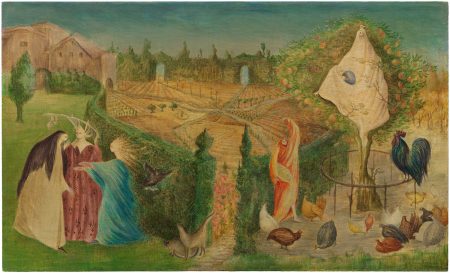During this time of quarantine, it’s enjoyable to get lost in The Kitchen Garden on the Eyot (1946) by Leonora Carrington (1917-2011). Delicately limned in egg tempera on a small panel, the scene is easy to enter online, and its cryptic serenity casts a rosy glow over one’s feelings of confinement.
A sense of mystery begins with the painting’s title. An eyot, or ait, is a small island, especially in a river. I like to think that the central courtyard—and, indeed, the painting as a whole—represents an eyot of magic in a humdrum world.

Leonora Carrington, “The Kitchen Garden on the Eyot,” 1946. Tempera on wood panel, 11 3/4″ x 19 11/16.” Collection of SFMOMA, © Estate of Leonora Carrington / Artists Rights Society (ARS), New York
In the left-hand foreground, three mystical women clad in medieval robes chat conspiratorially, appearing to practice spells. Beyond, a tall wall of manicured hedges encloses a vast central expanse imbued with improbable perspective, where staggered rows of trees, crops, and footpaths seem to shift back and forth from near to far. A dull beige manse presides over this cloistered land, which in turn feeds into a hazy golden grove to the painting’s center right. At the back wall in the distance, two hedge archways open to azure. We can only explore as far as our gaze, which leads back to the courtyard entrance where two sphinx-like blue-eyed felines pause, possibly waiting for their mistresses or returning from some roam. One cat stares hungrily upward at an ebony chicken standing on blue eggs inside the hedge flapping its wings as in fear, a harbinger of potential destruction and the vulnerability of living things. To the right of the entryway, a crone clad in red scatters bread for the fattening fowl. With a skeletal hand, she tosses crumbs upon her own person as if they were manna to restore her vigor. Nearby, a rooster looks expectantly at a spirit emerging from a fruit tree. Emblematic of nature’s life-giving force, this specter grasps a large egg, a symbol of regeneration, alchemic transmutation, and the medium with which Carrington created the painting.
Much has been written about Carrington’s real-life kitchen in Mexico City, which served as a gathering place and her laboratory for alchemical experiments. She followed recipes from hundreds-year-old cookbooks and served strange, inedible dishes (such as omelettes containing her hair) to guests at dinner parties. Like the sorceresses they painted, Carrington and her close friend Remedios Varo dabbled in the occult. They shared other Surrealists’ penchant for concocting bizarre dishes; but for them the practice was particularly significant. Cooking and painting were their methods of alchemic transmutation. In their visionary worlds, spheres of traditionally feminine domestic labor, such as kitchens, gardens, and dining rooms, become loci of magic and significance. The cultivated plot harboring fruits and poultry in The Kitchen Garden on the Eyot is embedded with metamorphic potential and the forces of vitality and death.
Throughout her oeuvre, comestibles and the act of eating play major roles in Carrington’s esotericism. Her short stories are replete with descriptions of magic edibles; ravenous creatures; and unorthodox food chains pervaded by power, horror, and rebirth. The artist frequently compared painting to cooking, eating, and alchemy. “Painting is like making strawberry jam, really carefully and well,” she once said. On another occasion, she declared, “You don’t decide to paint. It’s like getting hungry and going to the kitchen to eat. It’s a need, not a choice.” Carrington once dreamed of opening a women’s commune in Mexico, where members would study esoteric topics and eat meals out of the garden with their hands. This dream never came to fruition, but perhaps part of it lives on in her paintings.
Outside my window, gentle spring breezes animate green leaves against blue sky. Ideal weather renders confinement all the more discomposing; yet trapped inside, I may at any time venture out through my computer screen and into the window of Carrington’s painting whose mysterious terrain offers a renewed sense of hope, growth, and new beginnings.



